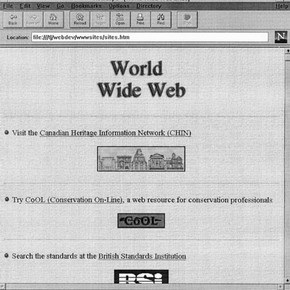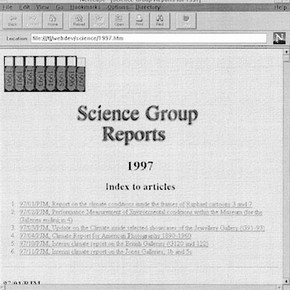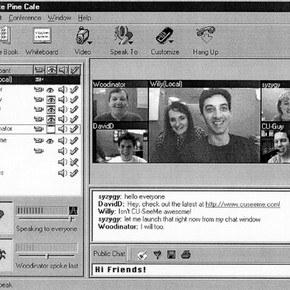Conservation Journal
October 1997 Issue 25
Conservation on the Internet: Practicalities and Possibilities
The Internet is an expanding global network of computers, connecting millions of world-wide users and with new users and information providers joining daily. Databases and information services have long been accessible on the Internet, but until recently they were hidden behind cumbersome interfaces, often requiring knowledge of a complex query language. Thus, in practice, access was restricted to specialists.
With the growth of the World Wide Web (WWW) the situation is rapidly changing. The WWW provides a 'point and click' interface to documents containing a mixture of text, images, sounds and videos, with 'hyperlinks' linking related topics.
To use the WWW you need a browser such as Netscape (Netscape Communications Corporation) that can be downloaded (see http://home.netscape.com) and an Internet connection (more later). A browser retrieves and displays documents from the WWW and highlights any links (usually referred to as hyperlinks) to other useful information sources. When you click on a hyperlink the browser retrieves and displays the document at the end of the link. These hyperlinks may be to documents on the same site, or a site elsewhere in the world. Hence, the term World Wide Web. The WWW is also capable of sending queries to traditional database systems and displaying the results.
The WWW is so synonymous with the Internet, that people miss the fact that the Internet has many more tools to offer. These are summarised below, however for a more detailed account see http://www.eff.org/papers/eegtti/eegttitop html*. It is worth noting that it is possible to use these tools from within some WWW browsers.
You can send messages to other Internet users provided they have an electronic mail address (E-mail); mine is cdtaylor@vam.ac.uk. E-mail tends to be delivered quickly and is excellent for disseminating information to geographically distant recipients. These messages are usually text, but increasingly E-mail is capable of handling documents with sounds and images. A variation on E-mailing a specific person is to use a 'mailbase'. These are based on discussions topics which have an associated list of subscribed users' E-mail addresses. When an E-mail is sent to the mailbase a copy is forwarded to the subscribed users. For example, there is a mailbase list for textile conservators using the E-mail address texcons@simsc.si.edu. Instructions for subscribing to this mailbase can be found at http://palimpsest.stanford.edu/byform/mailing* lists/texcons.
Another tool similar to E-mail is USENET news. Here messages are 'posted' to newsgroups, such as bit.listserv.museum-l, where they are held for a limited time. These postings are not forwarded to users, rather the user must access the newsgroup and read the messages, like a traditional noticeboard.
File Transfer Protocol (FTP) and Gopher enable you to move files safely from another Internet site to your own computer or vice versa. Both can have 'point-and-click' interfaces and organise the information hierarchically.
Wide Area Information Servers (WAIS) and TELNET allow you to search vast databases and run applications on remote machines respectively, but largely these have been replaced by the WWW's query support language.
The following is a brief description of just three WWW conservation sites, CoOL, CHIN and the forthcoming CONSOLE. You may want to use these sites as a starting point, or find other sites using the WWW search tools such as AltaVista (Digital Equipment Corporation, http://www.altavista.digital.com*).
1. CoOL (http://palimpsest.stanford.edu)
The Conservation On-Line (CoOL) site, at Stanford University Libraries, describes itself as 'a full text library of conservation information...of interest to those involved with the conservation of library, archive and museum materials'. It provides resources for reading papers on subjects ranging from Digital Imaging to Pest Management, for finding contact details of conservators and for finding information about conservation organisations and mailbases.
2. CHIN (http://www.chin.gc.ca )
The Canadian Heritage Information Network (CHIN) is a site that covers broad museum issues including conservation. Part of CHIN is the Conservation Information Network (CIN), which allows you to perform searches within databases including bibliographies, suppliers and materials.
3. CONSOLE
At present the V&A Conservation Department has a small Internet presence (https://www.vam.ac.uk/news/dept.html*). We are in the process of creating an Intranet (a museum-wide, but not world-wide Internet) called CONSOLE. Parts of this will eventually move to the Museum's Internet site. Work on the Intranet is proceeding in parallel with an information audit designed to identify information sources. As an example, the abstracts for the Science Group's reports have been made available on the V&A Intranet.
Connecting to the Internet will depend on your local circumstances. One route is through a dedicated Internet connection, such as through the UK's Joint Academic NETwork (JANET). Alternatively, more limited access can be achieved by subscribing to an Internet Service Provider (ISP), usually through a modem using the normal telephone lines. ISPs provide access to a selection of tools, such as E-mail and WWW, and may even provide space for you to publish WWW documents.
The biggest problem with the Internet as a day-to-day tool for conservation is lack of bandwidth. Bandwidth equates to the amount of information that a network can carry. Although bandwidths are often large they have to be shared by all the people trying to access information. Coupling this with the demands for bandwidth-greedy media, such as video, causes bottlenecks, making the Internet appear slow. More powerful networks and techniques, such as compression, are being developed to tackle this problem.
The avenues for future conservation Internet use are wide and varied. There are moves in the heritage field, most notably AQUARELLE (http://aqua.inria.fr*), to create vast archives of information online. These archives are held locally by information providers and can contain complex multimedia data, as well as databases. They can be browsed as WWW documents or a single query can perform an exhaustive search over all the archives. There is no requirement for the databases held in the system to be of the same type, as long as they support the query standard Z39.50 (http://renki.helsinki.fi/z3950/z3950pr.html*). Therefore, vast archives held by museums can be put on-line without major re-engineering. It is technically feasible, in a system like AQUARELLE, that all the conservation information from collections management systems could be made available.
Serious use of the Internet is often centred around groups collaborating on projects. As a classic example, video conferencing can be achieved over the Internet using products like CU-SeeMe (http://cuseeme.cornell.edu*). CU-SeeMe is a public domain software package for Macintoshs (Macs) and PCs. Each machine in the conference has CU-SeeMe , a microphone, and a cheap (less than £100) camera, which send pictures, audio and data to windows on each of the other participant's machines. The system also has a whiteboard where participants can work together on documents. Collaborative work offers great potential for conservation. For example, loan couriers could use it to communicate with the museum-based conservation teams.
The types of media that the Internet will be able to manage will also improve in time. Work has been going on for some time on a Virtual Reality Markup Language (VRML) which can describe and browse three-dimensional (3D) spaces. When bandwidth permits, the manipulation of complex 3D models of objects, perhaps created using 3D laser scanners, may become possible.
When collaborative and Internet technologies develop in the future, the conservation of an object could be debated by remote conservators using video conferencing, and conservation techniques 'tested' on 3D rendered models before physical treatment.
In summary, the Internet has great potential for the conservation profession. It allows collaboration and simple dissemination of information between geographically separated individuals and teams. There are a limited, but expanding, number of information providers. As future technologies develop more imaginative Internet uses for conservation will emerge.
* Please note, some web links provided in this article are no longer active, but were available at the time of printing.
October 1997 Issue 25
- Editorial
- Hearing the Original Instrument
- Preparations for 'Carl and Karin Larsson: Creators of the Swedish Style'
- Showcases - An External Perspective
- Pollution Monitoring Within the Historic Royal Palaces
- Conservation on the Internet: Practicalities and Possibilities
- Questions and Answers: Review of 'The Interface Between Science and Conservation'
- Conservation Under the Microscope: Two Reviews of RCA/V&A Conservation 1997
- Postcards From Paris
- Printer Friendly Version


